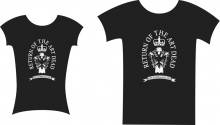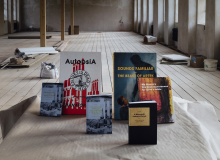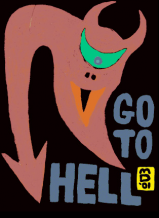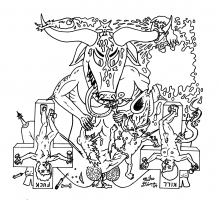| Revista Umělec 2003/2 >> Stoker’s long finger shadows | Lista de todas las ediciones | ||||||||||||
|
|||||||||||||
Stoker’s long finger shadowsRevista Umělec 2003/201.02.2003 Jiří Ptáček | performance | en cs |
|||||||||||||
|
These days people most often speak about artist Michal Pěchouček in the superlative. His talent is (suddenly or according to expectation — this is for each to decide) mature. Each step will therefore be observed with care. But let’s review what Michal Pěchouček has going for him: he has not gone the extra mile to curry public favor outside art territory; he is not the victim of quackish acts of self-propagation; nor has he simply slipped in among us. If one feels the needs to talk about Pěchouček’s intimate world, one must resort to looking at his work. This is no surprise, as the creative spirit radiates from his personality, in his extraordinary sensitivity for social outsiders, for his duty of compassion, and his natural understanding of the meanings of social etiquette. Actually, one could say that Pěchouček is an impervious personality, though in fact it is himself that he is offering.
The Collector This is not an article about the local peripeteia of Michal Pěchouček. Though it may appear to be. This is an imperfect casting of the next footprint he is currently leaving behind. This is a footprint that has its own beginning and end, toes and heel, which can be placed on a timeline — but one that will subsequently fall away. It all started with an invitation to his studio, for me and artist Jana Kalinová. At first I didn’t understand why I’d been invited. Michal Pěchouček said it would be an evening of wine and performance. But the very thought of a party was exhausting, and then the notion of the party itself quickly changed into my actual state of mind. With as much grace as I could muster, I turned down the invitation. Kalinová accepted, and the next day I learned what I had missed out on. Michal Pěchouček’s show was a supreme form of a presentation I had once seen in Pražák Palace in Brno. Pražák Palace Pěchouček’s gallery presentations often look like they are carefully cut from film reels. And this last one told a story that was cut up into uniform blocks; however, this time it was marked by the author’s tendency to paint with oils. But even thorough searches for his tipsy expression among the greens, blacks, beiges and browns could detract from the fact that the strip of pictures along the white attic hall was a collection of dissolves and cuts within a single story. What forged the links was more the notion of a drama than a clear narrative line. Iconic details from horror films — the shadow of a cat, mutant meat-eating houseplants or the black and red swirl of a Dracula robe and, in a few self-portraits, the individual movements of prolonged fingers — dissolved at the end of the series into a romantic waterscape of a ship on a stormy sea. Elsewhere it overflowed into the wasteland of empty hospital corridors and the shabbiness of a police uniform. Something happened here and most probably it was a crime. If there’s a cop in the scene there must be a crime — this was not the endless loop of the chicken and the egg. A cop doesn’t usually peck out a confession if there isn’t a suspect. But what crime was committed and did it really happen? Or does this matrix of clues signify that one has indeed taken place? The tension in a detective story always builds as we ride sidesaddle with the likes of Philip Marlowe, trusting that his six sense in the matter will show in the end that this, whatever we are investigating, is not for nothing. So, in this case, what did the rearrangement of objects on the surgery table in two consecutive pictures say? What about the artist’s cut into the story, is it to further complicate the upcoming scene? What if the narrator himself is a criminal, if he is the will-o’-the-wisp leading us away from a final solution? But then, what was taking place in the TV screen in the entrance to the hall was truly exceptional. The Collector II I wanted to see this live. I made an appointment with Pěchouček to see his studio. I used some guests from Berlin, who were searching out Czech artists in Prague to sell abroad, to camouflage my curiosity. We got to the studio on National Avenue after dark. Michal Pěchouček welcomed us heartily and led us to the tidy studio, where he not only paints but also teaches his students. The main and largest room was clean and had a linoleum floor. In the middle of the room was a small table braced by a cluster of chairs, three of which were already occupied by guests. So now there were eight of us. Along the wall was a kind of low stage, partly covered by a dull black cloth curtain. Under it, you could just make out the edges of a picture. As I had seen the show in Brno, I knew what to expect. The artist switched on music from Hitchock’s Psycho and pulled the curtain back. Then, one by one, he brought out the pictures from a storeroom and placed them in a row. The show became one of gradual suspense. The music seemed to guide Pěchouček, without him losing his unpretentious quirkiness or lowering himself to theatrical toying with his audience. A particular musical theme meant a waiting game before one picture scene. The moment the atmosphere transformed, he brought out a new picture. The many pauses and entries limited the possibility of looking at a painting to one’s liking, thereby creating the feeling that the pictures were disappearing from sight all too quickly. The series closed with credits to his colleagues (script: Bram Stoker!) and a portrait of a nurse with a red look. The artist gave a short bow to the clapping of sixteen hands, and slowly conversation picked up “as if nothing happened.” And after a short time, an encore performance, but this time even more precisely executed. The two variations of the video recording from Pražák Palace took on even more meaningful dimensions in direct contact. The documentary quality of the VHS recording made the principle of presentation accessible in quality information. But in the studio there was also the urge to stop Pěchouček in order to examine the painting, if it didn’t mean blatantly disrupting the artist’s intention. And the “dance of forms,” which Pěchouček’s journey between the two rooms ultimately became, materialized as soon as we realized that we were the silent co-designers of an unrepeatable action of both time and space. Studio on National Avenue Michal Pěchouček’s performance is based on reciprocity. In fact, one has no idea when and where it starts. It could be at the moment of invitation, a welcome at the door, in a conversation or as he hits the “play” button. It indicates an event outside the territory of theater performance and artifact. And the viewer becomes the direct reason for concentration and effort. Of course: during the performance this film happening shouldn’t be confused for film; it’s more like theatrical props. But the paintings debunk the composition — hallmark sets of fears, doubts and worries. Alfred Hitchcock was famous for his unscrupulous investigation of situational reactions and sensational codes of fear, and for the experiments he performed on his immediate surrounding. When Pěchouček recasts these codes, he pares the original film image flow down to singularities, while at the same time characterizing this flow as a code of cliches and repeated appropriations. This is reminiscent of film patterns and we therefore don’t fall into examining the esthetic aspects of oil painting. And that is why we are still afraid. Not because of any real source of fear, but because of his ordinary representation. The fear doesn’t come from seeing a bogeyman, but simply because everything suggests that we should be afraid. This is nothing new: We are also afraid of the dark, perhaps only because we were “told” to be afraid of it, not because of any bad experiences with it. Darkness is a simple physical phenomenon, filled with notions and old animal reflexes. The Collector III You can try it yourself. Michal Pěchouček said he will comply with any requests. In this lies the important social aspect of his performances: he does not invoke a chimera of community intimacy. He doesn’t milk the numbed sensors of random people in public space. Instead he chooses to open himself up to factual investigation. But when I asked him if we could publish his phone number, he said he preferred to give his e-mail address. That’s when it hit me: in every other horror flick, answering the telephone is a matter of life and death. Michal.Pechoucek@seznam.cz
01.02.2003
Artículos recomendados
|
|||||||||||||
|
04.02.2020 10:17
Letošní 50. ročník Art Basel přilákal celkem 93 000 návštěvníků a sběratelů z 80 zemí světa. 290 prémiových galerií představilo umělecká díla od počátku 20. století až po současnost. Hlavní sektor přehlídky, tradičně v prvním patře výstavního prostoru, představil 232 předních galerií z celého světa nabízející umění nejvyšší kvality. Veletrh ukázal vzestupný trend prodeje prostřednictvím galerií jak soukromým sbírkám, tak i institucím. Kromě hlavního veletrhu stály za návštěvu i ty přidružené: Volta, Liste a Photo Basel, k tomu doprovodné programy a výstavy v místních institucích, které kvalitou daleko přesahují hranice města tj. Kunsthalle Basel, Kunstmuseum, Tinguely muzeum nebo Fondation Beyeler.
|






































 New book by I.M.Jirous in English at our online bookshop.
New book by I.M.Jirous in English at our online bookshop.
Comentarios
Actualmente no hay comentariosAgregar nuevo comentario